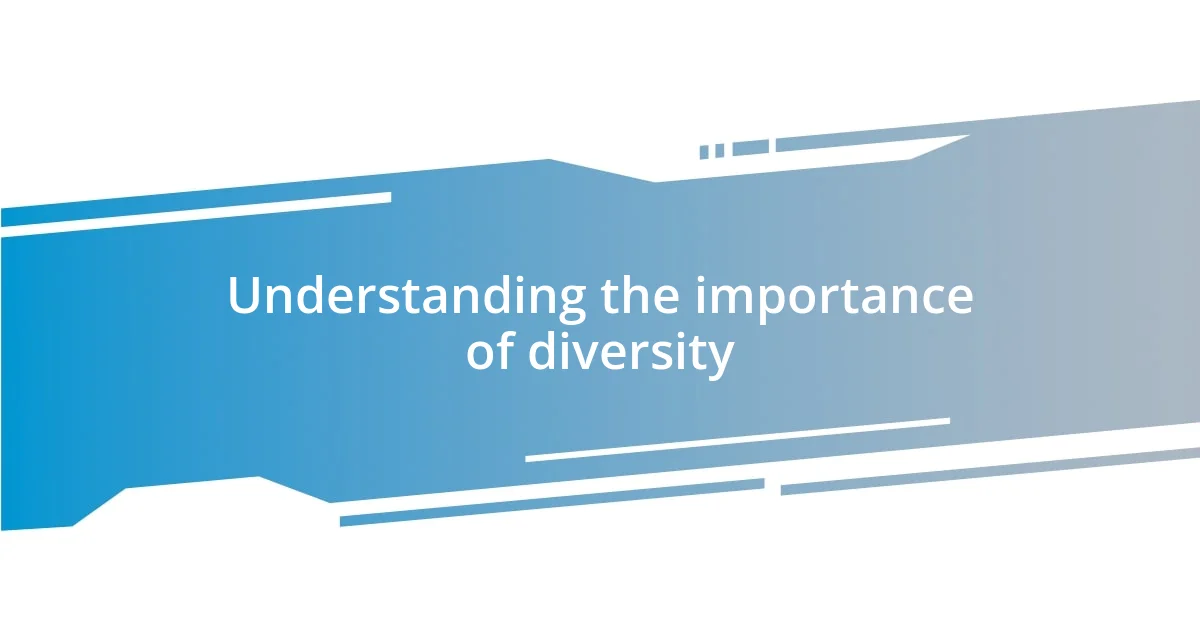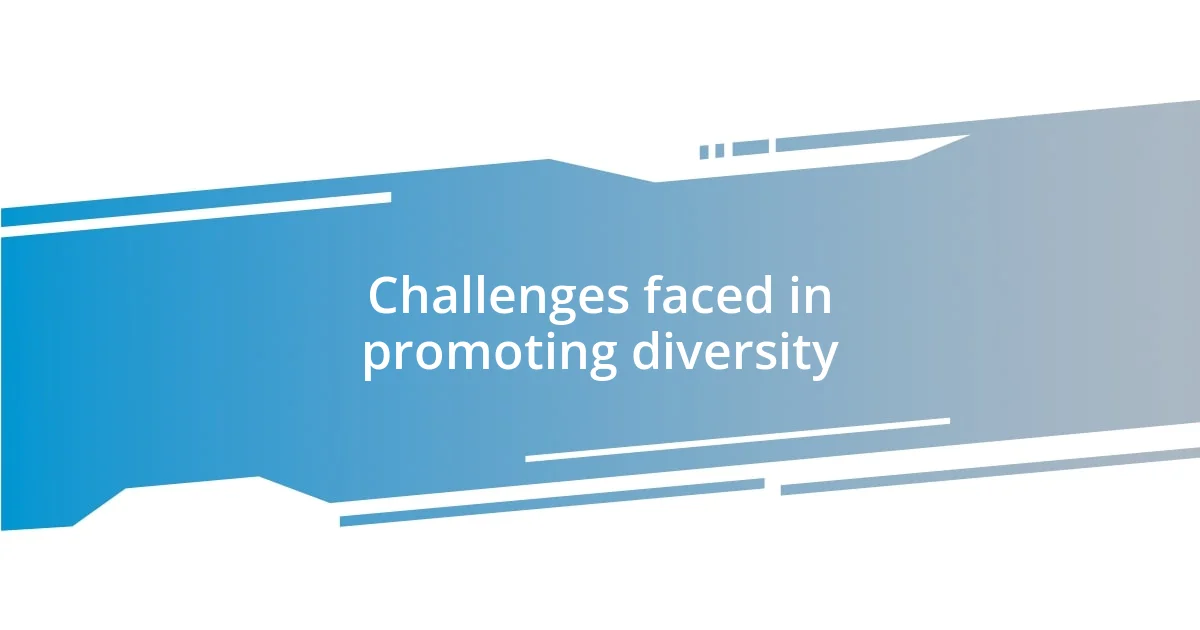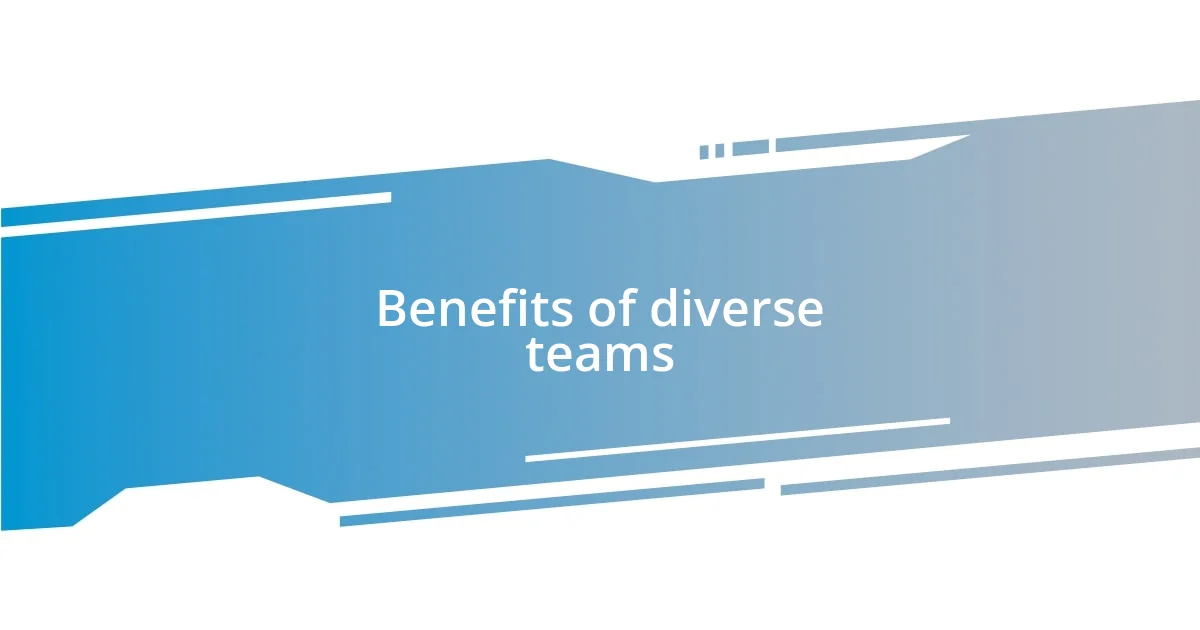Key takeaways:
- Diversity enhances innovation and problem-solving by bringing together unique perspectives, boosting creativity and comprehensive solutions.
- Challenges in promoting diversity include unconscious bias, resistance to change, and tokenism; addressing these requires ongoing dialogue and dedicated resources.
- Successful diversity initiatives, such as mentorship programs and community-driven collaborations, significantly improve workplace culture, employee satisfaction, and client relationships.

Understanding the importance of diversity
Diversity is more than a buzzword; it’s a key ingredient for innovation and problem-solving. I remember working on a project where our team was incredibly diverse—people from different backgrounds brought unique perspectives that led to solutions I wouldn’t have considered on my own. Isn’t it fascinating how differing viewpoints can lead to breakthroughs that benefit everyone?
When I reflect on my own experiences, I see the impact of diversity in how we relate to our clients. Having team members who understand varied cultural contexts can transform communication and build trust. Have you ever thought about how your interactions could change if you had a more diverse team supporting you?
Ultimately, embracing diversity means creating an environment where everyone feels valued and heard. This not only boosts morale but also encourages a sense of belonging—something I deeply cherish in my professional life. Isn’t the feeling of being part of a collective, where each voice counts, something we all strive for?

Challenges faced in promoting diversity
Promoting diversity comes with its own set of challenges that can sometimes feel overwhelming. From my experience, one significant hurdle is overcoming unconscious biases that linger in recruitment and promotion processes. I recall sitting in meetings where decisions were made without fully recognizing how marginalized voices could elevate our discussions. It’s a stark reminder of how these biases can silently shape our industry, hindering genuine progress.
Here are a few specific challenges that often arise:
- Unconscious Bias: Many individuals may not even realize they hold biases that affect their decision-making.
- Resistance to Change: People often feel uncomfortable stepping outside of their comfort zones, making it difficult to adopt new diversity initiatives.
- Tokenism: There’s a risk of merely checking boxes rather than fostering true inclusion, which can alienate those we aim to support.
- Lack of Resources: Many organizations don’t allocate sufficient resources or training to effectively implement diversity programs, making meaningful change harder to achieve.
Addressing these obstacles requires a conscientious effort from everyone involved. I think it’s important to create a culture of ongoing dialogue where these issues can be discussed openly, helping all of us grow together.

Benefits of diverse teams
Diverse teams bring a wealth of creativity to the table, as members draw from their unique experiences and backgrounds. I remember collaborating with a team that included individuals from various parts of the world, each shedding light on different aspects of a problem we faced. The ideas that emerged were not only innovative but also more comprehensive. Isn’t it amazing how tapping into diverse perspectives can lead to truly original concepts?
Moreover, diverse teams often perform better in problem-solving situations. I’ve found that teams with varied viewpoints tend to evaluate challenges more thoroughly, leading to quicker and more effective solutions. This was particularly evident during a critical project of mine, where brainstorming sessions turned into vibrant discussions filled with energy and unique insights. Can you think of a time when a different perspective helped you overcome an obstacle?
Lastly, companies with diverse teams are more likely to understand and cater to a broader client base. For instance, I’ve seen firsthand how having team members who speak different languages and grasp cultural subtleties can enhance client relationships significantly. It feels rewarding knowing that our work resonates across different demographics. How does knowing your team can connect with a wider audience influence your own work?
| Benefit | Description |
|---|---|
| Increased Creativity | Diverse teams generate a broader range of ideas and creative solutions. |
| Enhanced Problem-Solving | Teams with varied perspectives tend to find solutions faster and more effectively. |
| Broader Client Understanding | Diversity allows teams to connect better with clients from different backgrounds. |

Strategies to enhance diversity
Creating strategies to enhance diversity in our industry starts with prioritizing education and awareness. I remember attending a workshop on unconscious bias that completely changed my perspective. It made me realize how deeply ingrained these biases can be, often leading to middle managers making decisions that unintentionally exclude qualified candidates. Don’t you think investing in such training could be a game-changer for many organizations?
Another effective strategy is to implement mentorship programs, connecting individuals from diverse backgrounds with leaders in the organization. I once mentored a talented intern who felt isolated in a predominantly homogeneous environment. Watching her gain confidence while sharing her unique insights was not only uplifting for her but also transformative for our team. How can we create more spaces where diverse voices feel empowered to speak up?
Furthermore, establishing diversity-focused recruitment practices can significantly impact outcomes. For instance, I’ve seen companies use blind recruitment techniques, stripping away names and identifying details from applications. This not only levels the playing field but also encourages a richer pool of talent to emerge. Isn’t it exciting to think about how much creativity and innovation we could unlock by simply redefining our approach to talent acquisition?

Measuring diversity in the workplace
Measuring diversity in the workplace is a critical yet often overlooked task. I recall a time when our team conducted an internal audit to assess demographic representation. The findings were eye-opening, revealing gaps we hadn’t even considered, and sparking a passion in me to push for more inclusive hiring practices. Have you ever been surprised by what lies beneath the surface of your organization?
I believe that tracking metrics is only part of the equation; we also need to measure the impact of diversity initiatives on employee engagement and satisfaction. For instance, after implementing anonymous surveys to gather feedback on inclusion, I was struck by the candid responses from colleagues who felt their voices were sometimes unheard. This data didn’t just highlight our shortcomings; it showed us the path forward, emphasizing the importance of listening as much as measuring. How often do we take the time to truly hear those around us?
In my experience, establishing a diversity scorecard can provide a clear view of progress over time. I’ve been part of teams that utilized this tool to set specific, measurable goals for hiring and retention. It felt rewarding to see the needle move, but even more fulfilling was witnessing how these changes bolstered our workplace culture. Isn’t it inspiring when you can track something tangible that reflects your commitment to diversity?

Case studies of successful diversity
One standout case of successful diversity comes from a tech startup I knew well. They implemented a unique strategy by hosting hackathons focused specifically on underrepresented groups. The energy in the room was palpable as teams from diverse backgrounds collaborated on innovative projects. I still remember the brilliant ideas that emerged, reflecting a breadth of perspectives that wouldn’t have surfaced in a more homogenous setting. Isn’t it fascinating how diversity can fuel creativity?
Another inspiring example is a large corporation that introduced employee resource groups (ERGs) to foster community among diverse employees. I remember attending one of their meetings, where individuals shared personal stories and experiences that shaped their lives and careers. The emotional connections strengthened team dynamics and promoted a culture of understanding and support. Have you ever felt the power of a shared experience in your workplace?
Lastly, I recall a hospitality company that embraced diversity as a core value, leading to remarkable results in customer satisfaction. By training staff to understand different cultural perspectives, they created an environment where guests from all backgrounds felt welcome. The increase in positive reviews and return visits was undeniable. Can you imagine the impact of truly understanding and valuing every guest’s unique story?

Future trends in industry diversity
The future of diversity in our industry is likely to shift towards prioritizing mental health and well-being as core components within diversity initiatives. In my own journey, I’ve seen how creating spaces for conversations around mental health not only supports marginalized voices but also fosters a sense of belonging for everyone. Isn’t it interesting how mental well-being intersects with diversity, emphasizing that inclusion goes beyond race and gender?
As we look ahead, technology will play a significant role in enhancing diversity efforts. Automation and artificial intelligence can help identify biases in hiring processes, leading to fairer outcomes. I remember when a colleague of mine shared their experience using AI-driven platforms to analyze job descriptions, revealing language that could deter diverse candidates. Have you ever considered how a simple change in wording can open doors to untapped talent?
We might also witness a surge in community-driven initiatives that encourage collaboration between industries. Just the other day, I attended a workshop where multiple organizations came together to share best practices for fostering diversity. The vibrant discussions reminded me how collective wisdom can create stronger, more inclusive environments. How exciting is it to think about the possibilities that partnerships between industry leaders could unlock for the future of diversity?
















